9.2 /10 1 Votes9.2
4.4/5 Let's Play SEGA Initial release date 15 December 1989 | 4.7/5 CoolROM Programmer(s) Takashi Iwanaga | |||||||||||||||||||||||||||||||||
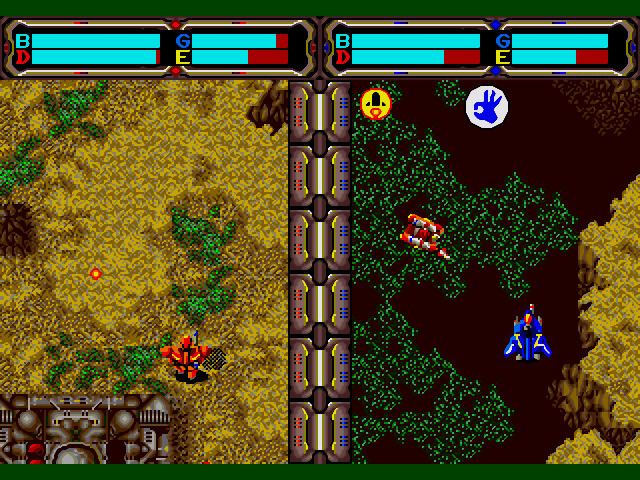 | ||||||||||||||||||||||||||||||||||
Composer(s) Naosuke AraiTomomi Ōtani Release date(s) JP: December 15, 1989NA: April 1990EU: 1990 Genre(s) Real-time strategyMOBA Modes Single-player video game, Multiplayer video game (Split screen) Similar Technosoft games, Shooter games | ||||||||||||||||||||||||||||||||||
Classic game room herzog zwei 2015 review for sega genesis
Herzog Zwei is a Sega Genesis-exclusive game by Technosoft, published in 1989 (released in North America and Europe in early 1990). It is an early real-time strategy game, predating the genre-popularizing Dune II. Herzog Zwei combines the arcade-style play of Technosoft's own Thunder Force series with a simple, easy-to-grasp level of strategy. It was also a precursor to the MOBA genre.
Contents
- Classic game room herzog zwei 2015 review for sega genesis
- Classic game room hd herzog zwei on sega genesis part 1
- Gameplay
- Mechanics
- Levels
- Reception and legacy
- Legacy
- References
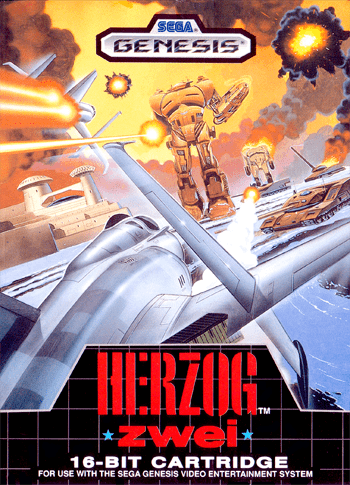
Herzog Zwei (German pronunciation: [ˈhɛɐ̯tsok ˈtsvai]) translates from German to "Duke Two". It is the sequel to Herzog, which was available on the Japanese MSX and PC-8801 personal computers.

Classic game room hd herzog zwei on sega genesis part 1
Gameplay
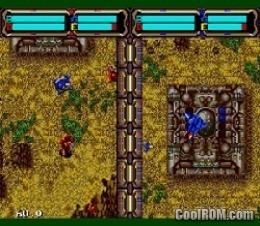
In Herzog Zwei, the player directly pilots a flying, transforming mech (similar to the variable fighter depicted in Macross), a multi-role vehicle suited for utility and combat. Through the mech, the player purchases surface combat units, airlifts them across the battlefield, and issues them orders. These command activities can only be performed through the mech. Vehicles follow their assigned orders (which are fairly basic: patrol, garrison, capture base) until they either run out of fuel or are destroyed. Tactical re-deployment (mission reassignment, vehicle repair) involves a great deal of micromanagement, due to the required involvement of the mech.
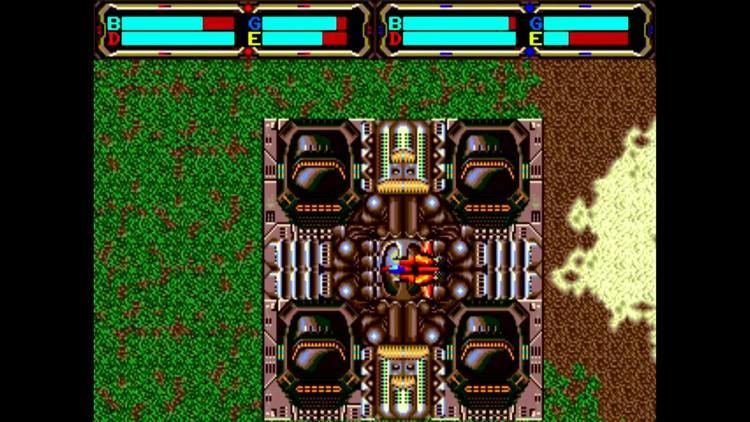
Both the player's ground forces and the mech have finite fuel and ammunition. A prolonged engagement requires considerable micromanagement, as vehicles will not auto-repair, and the fragile combat-supply vehicles have a limited radius of service.
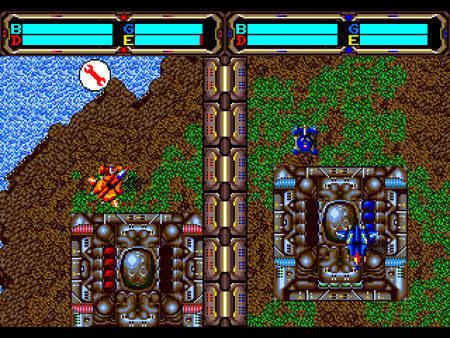
With a total of eight different types of land units to purchase, the player can determine the composition of his army. Each combat vehicle type represents a tradeoff between speed, anti-air, ground-attack, and cost. Units are assigned mission orders from a menu selection: "fight from a fixed position", "patrol this area", "fight in fixed radius," "go to/attack/occupy intermediate base." New orders can only be issued during the airlift, and every time a unit's mission orders are reassigned, a cost is incurred.
In addition to the player's main base, there are nine permanent outposts scattered across the battlefield. These indestructible buildings are the only production resources on the battlefield players. Once under a player's control, an outpost generates additional revenue (for purchase of units) and serves as a remote base of operations (repair/refuel, pick up delivery of purchased unit.) A key strategy is to capture as many outposts as possible or deny enemy use through nuisance actions.
Herzog Zwei supports both single player mode (against the AI), and two-player mode (head-to-head). In single-player mode, the entire screen is devoted to the human-player's field of view. However, the game's unsophisticated AI renders the single-player experience lacking. The game partially offsets the AI's inherent weakness by increasing the armor and offensive damage of computer player side with each advancing level.
Mechanics
The mechanics of Herzog Zwei have a slower feel than most modern RTS games. The player's view of the screen is always centered on the player's mech. The player can pilot the mech to any location on the map while shooting at enemy units, airlifting friendly ground vehicles, or placing purchase orders for more vehicles. If the mech is destroyed in battle (or runs out of fuel), a new mech respawns over the player's primary base. Unlimited respawning allows the mech to engage in suicide tactics, as it is essentially a disposable asset.
Although the vehicle-purchasing menu can be activated from anywhere on the battlefield, only one vehicle may be purchased at a time. The completed order must pick up from a friendly base (by the player's mech) before the next purchase can be made. The game has a hard upper limit of 100 active units (50 per player.) But when a game session exceeds seventy active units, the console slows down, making play difficult.
Herzog Zwei requires the mech-vehicle to airlift vehicles for close inspection and mission-reassignment. Later RTS games use the virtual console style of interface, allowing direct control of any player-owned vehicle.
To complete the game in single-player mode, the player must defeat the computer on each level four times, each time representing an increasing level of difficulty. When the game is completed, the ending offered differs depending on whether the player played as the first player (red), or the second player (blue). Two-player mode divides the screen into two playfields. Each player can see the opponent's actions, eliminating any element of surprise.
Levels
A key aspect of the gameplay is how the player interacts with the environments of the different levels. Each of the eight levels takes place in a different location that requires a different strategy for attacking the other side. Some levels have a large, physical barrier in the middle of the level that prevents a user from launching a direct ground attack at the main base in a timely fashion. For example, the jungle stage Waldung has a large swamp in the middle of the board that slows troops movement and eats up energy. Other levels, such as the volcano stage Vulkan are covered in lava rivers that will destroy any unit that comes in contact with it. This makes it difficult to launch ground assaults against the main bases as well as the mini-bases as the individual units artificial intelligence is quite limited. Only three of the levels, Strand, Eisfrei, and Oase, have bodies of water that allow boats to be launched against the enemy. The Abgrund level features a river but the player is not allowed to purchase boat units.
On all levels except for Abgrund, both sides start off with a certain number of mini-bases already claimed. In Abgrund, all bases are neutral, including those directly near the main base.
Reception and legacy
Herzog Zwei was not a huge commercial success, due to its lack of marketing, relatively early release on the Genesis platform, and non-arcade genre on what was considered an arcade game console. Upon its 1990 release in North America, Electronic Gaming Monthly gave the game a rating of 4.25 out of 10, based on four individual reviewer scores of 4, 6, 4, and 3.
The game's reception in Europe was generally more positive. In the United Kingdom, in the April 1990 issue of Computer and Video Games, reviewer Paul Glancey gave the game an 82% score. He described it as "a game of conquest between two commanders in real time" and stated that what "sets it apart from other strategy games is that everything happens in real time. Both players are in action simultaneously and there are no pauses while decisions are taken so you have to think on the move or die." He noted that the command icons are "fairly easy to grasp" and concluded that it is a game that helps establish the Mega Drive as a "real" computer rather than "a machine for immobilized arcade players." Warren Lapworth reviewed the game in the March 1990 issue of The Games Machine magazine, giving the game a 75% score. He described it as an "unusual product" and stated that "Whether it's intended to get strategists to consider buying the console or to broaden the horizons of trigger-happy lunatics, I don't know. Either way, it's quite refreshing and can be quite addictive in two-player mode, fierce rivalry developing between friends." In France, the game was reviewed in the November 1990 issue of Joystick magazine, where reviewer JM Destroy gave the game a 78% score. The game was particularly well received in Germany, where it was known as Herzog 2, with Power Play magazine giving it an 80% score in its April 1990 issue, while Play Time gave it an 85% score in its June 1991 issue.
Retrospective reviews have been very positive. David Filip of Allgame gave the game a score of 4 out of 5 stars, describing it as "one of the first" and "one of the best" strategy video games on home consoles and as "a fine cure for those days when you want a different kind of RTS to control." Daniel Thomas of Sega-16 gave it a score of 10 out of 10 in 2004, describing it as "very probably the finest video game you've never played" and as the Genesis console's "finest hour." Lawrence Wright of Insomnia gave the game a score of 5 out of 5 stars in 2008. GameSpot users have given Herzog Zwei an average score of 8.8 out of 10 as of 2009.
It is often found on several "best of..." lists of video games, owing to its precedence in the real-time strategy genre, as well to the increasing understanding of finer points of its mechanics. It was featured in the "Top 100 Games Ever" list of Electronic Gaming Monthly, in the November 1997 issue which ranked it at #43, and in the January 2002 issue which ranked it #52. The February 1999 issue of Next Generation ranked it at #39 on its list of 50 best games of all time. It has also been featured in IGN's "Top 100 Games of All Time", in the 2003 list which ranked it at #62, and in the 2005 list which ranked it #95. In 2003, GameSpy listed the game as one of the 25 most underrated games of all time. 1UP.com included the game in its "Essential 50" list of "The Most Important Games Ever Made". The U.S. game release packaging art was executed by veteran San Francisco game box illustrator Marc Ericksen, who had previously done the art for Thunder Force II, and was invited back by Sega for this image, as it was considered a 'sister' game to TFII.
Legacy
The game concept of a central command/fighting vehicle directing other friendly units to attack remote enemy base appeared in past games, such as Sir Tech's 1984 game Rescue Raiders. However, Scott Sharkey of 1UP.com states that the 1988 game Modem Wars was possibly "[t]he closest predecessor" to Herzog Zwei, but that it "was fairly primitive and abstract by comparison," that earlier such games lacked the ability to construct units or manage resources which made them "much more tactical than strategic," and that the slower processors made the ticks "so long that the games were practically turn based". The closest modern equivalent to Herzog Zwei is considered to be MOBA games, which it was a precursor to. However, MOBA (also known as action RTS) give the player control over a fully customizable command unit with role-playing video game elements, while severely limiting or removing the player's ability to produce and command other friendly units. Total Annihilation (1997) and its spiritual successor Supreme Commander also inherit the concept of a large robotic command vehicle which is used to construct and command an army. However, Total Annihilation and Supreme Commander are controlled in similar fashion to traditional real-time strategy games; unlike in Herzog Zwei, the command vehicle in those games is mainly nothing more than a particularly powerful and versatile unit.
The producers of Dune II acknowledge Herzog Zwei as an influence, as do the producers of Warcraft (1994), Command & Conquer (1995), Starcraft (1998), War of the Rings (2003), and Brütal Legend (2009). Herzog Zwei is also considered a predecessor to the MOBA subgenre, also known as action RTS, though a key difference is that Herzog Zwei has a fully customizable command unit with role-playing video game elements that the player has full control over, while commanding an army to go into battle with rather than mindless drones that respawn at set intervals.
A sequel was planned for Sega's 32X platform, but with the subsequent failure of that console, so, too, died the plans for a third Herzog title. With Techno Soft closing its doors in 2001 and the status of the intellectual property being unknown, the future of the series is likely sealed.
On November 8, 2012, Carbon Games released AirMech, a game that is a more direct successor of Herzog. It features modernized graphics and added gameplay mechanics, such as online multiplayer. The game has been released under a free-to-play model, and is available from Carbon Games, Steam, and the Google Chrome Web Store.
